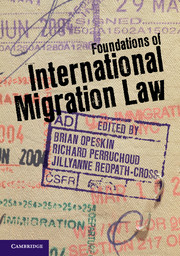Book contents
- Frontmatter
- Summary contents
- Detailed contents
- Preface
- List of case studies
- List of boxes
- List of figures
- List of maps
- List of tables
- Notes on contributors
- Abbreviations
- 1 Conceptualising international migration law
- 2 Contemporary patterns of international migration
- 3 Sources of international migration law
- 4 Nationality and statelessness
- 5 State sovereignty and freedom of movement
- 6 International human rights of migrants
- 7 Refugees and asylum
- 8 Women, children and other marginalised migrant groups
- 9 Human trafficking and smuggling
- 10 International migration by sea and air
- 11 International labour migration
- 12 International trade law and labour mobility
- 13 Global migration institutions and processes
- 14 Regional processes, law and institutional developments on migration
- 15 Emerging legal issues in international migration
- Appendix 1 Cases
- Appendix 2 Treaties and other international instruments
- Glossary
- Index
- References
11 - International labour migration
Published online by Cambridge University Press: 05 November 2012
- Frontmatter
- Summary contents
- Detailed contents
- Preface
- List of case studies
- List of boxes
- List of figures
- List of maps
- List of tables
- Notes on contributors
- Abbreviations
- 1 Conceptualising international migration law
- 2 Contemporary patterns of international migration
- 3 Sources of international migration law
- 4 Nationality and statelessness
- 5 State sovereignty and freedom of movement
- 6 International human rights of migrants
- 7 Refugees and asylum
- 8 Women, children and other marginalised migrant groups
- 9 Human trafficking and smuggling
- 10 International migration by sea and air
- 11 International labour migration
- 12 International trade law and labour mobility
- 13 Global migration institutions and processes
- 14 Regional processes, law and institutional developments on migration
- 15 Emerging legal issues in international migration
- Appendix 1 Cases
- Appendix 2 Treaties and other international instruments
- Glossary
- Index
- References
Summary
INTRODUCTION
Regulation of labour migration today remains largely a matter for States, which retain the sovereign prerogative to determine which non-nationals may enter and take up employment in their territory, and there is currently no global system for regulating international labour migration. Moreover, demographic projections for the next forty years suggest that international labour migration will become an increasingly important factor in sustaining the productivity of national economies. Unlike free movement of goods and capital, however, the movement of labour across international borders involves human beings, with profound social implications for countries of origin and destination. While international trade law regulates to a certain degree the movement of persons in the context of service provision, for the time being this system is confined to the temporary movement of a limited category of skilled persons, such as managers, business visitors and specialists, and is hardly aligned with national immigration regulations (see Chapter 12).
The human dimension of international labour migration was captured as early as 1919 in the Preamble to the Constitution of the International Labour Organization, which considers exploitative labour conditions as a threat to world peace and calls for an improvement in these conditions, including ‘protection of the interests of workers when employed in countries other than their own’. The Declaration concerning the Aims and Purposes of the International Labour Organisation (1944) (‘Declaration of Philadelphia’), annexed to the Constitution, also reaffirms the fundamental principle that ‘labour is not a commodity’. The founding documents of the International Labour Organization (‘ILO’) thus recognise that the protection of migrant workers is an imperative part of the response to international labour migration.
- Type
- Chapter
- Information
- Foundations of International Migration Law , pp. 283 - 311Publisher: Cambridge University PressPrint publication year: 2012
References
- 4
- Cited by

